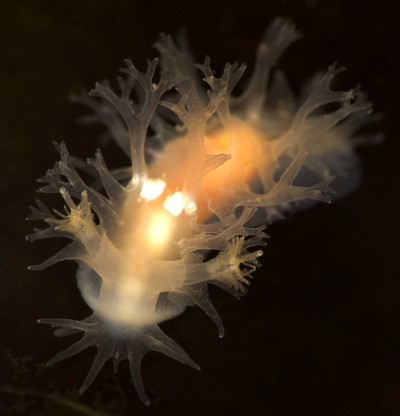
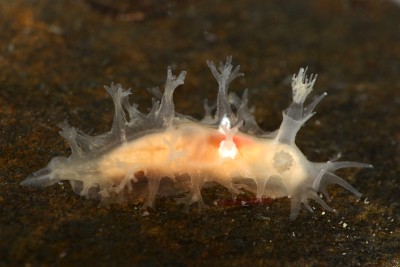
Tritonia myrakeenae
Bertsch & Mozqueira, 1986
Order: NUDIBRANCHIA
Suborder: DENDRONOTINA
Family: Tritoniidae
DISTRIBUTION
Ranges from the southern California bight (Bertsch and Mozqueira, 1986; personal observations) to Costa Rica (Camacho-Garcia et al. 2005).
PHOTO
Bird Rock, La Jolla, Intertidal, California, Pacific Ocean, 30 May 2009, Rocky shore. Length: 8 mm. Photographer: Brenna Green.
Tritonia myrakeenae is a diminutive, cryptic tritoniid that ranges from the southern California bight (Bertsch and Mozqueira, 1986; personal observations) to Costa Rica (Camacho-Garcia et al. 2005). It occurs intertidally, usually in association with the undescribed, tan to pale salmon-colored, stoloniferous octocoral, Clavularia sp., on which it likely feeds (personal observations). The body is translucent, revealing the pale orange to red viscera, and often has a pair of opaque white blotches dorsally. According to Bertsch and Mozqueira (1986) it reaches a total length of 18 mm; specimens we have seen in southern California are typically 10 mm or less.
Tritonia myrakeenae lays small, coiled egg ribbons (http://slugsite.us/bow/nudwk111.htm), which sometimes show gaps in the distribution of egg capsules. It is not clear if these gaps represent breaks in the egg stream during oviposition, or shifting of egg capsules after oviposition [see message #22536]. The eggs average less than 80 microns in diameter and take 8 days (at 16 - 18 degrees C) to develop into planktotrophic veligers with type 1 coiled shells averaging about 125 microns in length at hatching (Goddard 2004, unpublished data).
Hans Bertsch and Antonio Mozqueira Osuna named this species in honor the eminent American Malacologist A. Myra Keen.
-
Bertsch, H. & Mozqueira Osuna, A. (1986). A new species of Tritonia (Nudibranchia) from southern California and Baja California. The Nautilus 100(2): 46-49.
-
Camacho-Garcia, Y., Gosliner, T.M. & Valdes, A. (2005). Field guide to the sea slugs of the tropical eastern Pacific. California Academy of Sciences, San Francisco, California.
-
Goddard, J.H.R. (2004). Developmental mode in benthic opisthobranch molluscs from the northeast Pacific Ocean: feeding in a sea of plenty. Canadian Journal of Zoology 82(12): 1954-1968.
Goddard, J.H.R. & Green. B., 2009 (October 16) Tritonia myrakeenae Bertsch & Mozqueira, 1986. [In] Sea Slug Forum. Australian Museum, Sydney. Available from http://www.seaslugforum.net/find/tritmyra
Related messages
Further information on Tritonia myrakeenae
October 16, 2009
From: J. Goddard & B. Green
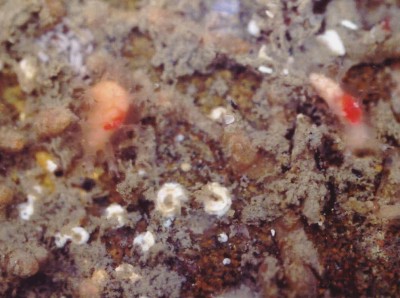
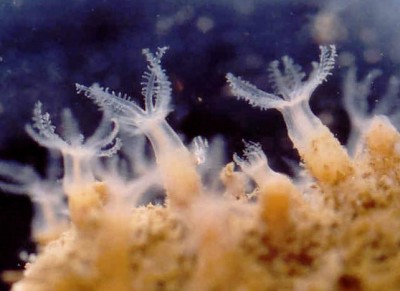
Hi Bill,
To accompany our previous message [#22536 ] on Tritonia myrakeenae, here is an image of two T. myrakeenae among contracted polyps of their octocoral prey, Clavularia sp., plus two more images of the octocoral.
Locality: Bird Rock, La Jolla, Intertidal, California, Pacific Ocean, June 2000, Rocky shore. Length: 8 mm. Photographer: Jeff Goddard.
Best wishes,
Jeff Goddard and Brenna Green
goddard@lifesci.ucsb.edu
Goddard, J.H.R. & Green. B., 2009 (Oct 16) Further information on Tritonia myrakeenae. [Message in] Sea Slug Forum. Australian Museum, Sydney. Available from http://www.seaslugforum.net/find/22537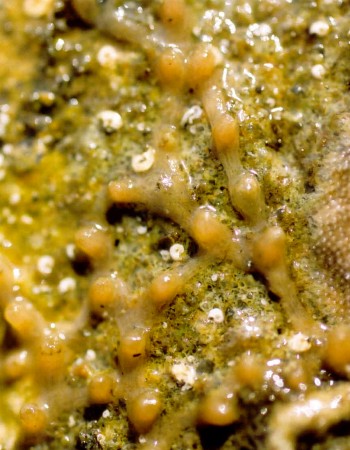
Thanks Jeff and Brenna,
Best wishes,
Bill Rudman
Factsheet for Tritonia myrakeenae from California
October 16, 2009
From: Jeff Goddard & Brenna Green
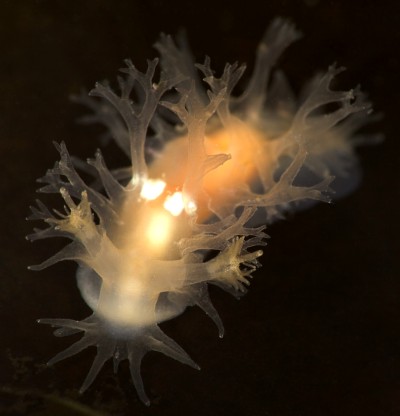
Hi Bill,
Here are some images and material for a Factsheet for Tritonia myrakeenae Bertsch and Mozqueira, 1986 for the Forum.
Tritonia myrakeenae is a diminutive, cryptic tritoniid that ranges from the southern California bight (Bertsch and Mozqueira, 1986; personal observations) to Costa Rica (Camacho-Garcia et al. 2005). It occurs intertidally, usually in association with the undescribed, tan to pale salmon-colored, stoloniferous octocoral, Clavularia sp., on which it likely feeds (personal observations). The body is translucent, revealing the pale orange to red viscera, and often has a pair of opaque white blotches dorsally. According to Bertsch and Mozqueira (1986) it reaches a total length of 18 mm; specimens we have seen in southern California are typically 10 mm or less. We have included some photos of its food in a separate message [#22537].
Locality: Bird Rock, La Jolla, Intertidal, California, Pacific Ocean, 30 May 2009, Rocky shore. Length: 8 mm. Photographer: Brenna Green.
Tritonia myrakeenae lays small, coiled egg ribbons (http://slugsite.us/bow/nudwk111.htm), which as seen in the attached image, sometimes show gaps in the distribution of egg capsules (it is not clear if these gaps represent breaks in the egg stream during oviposition, or shifting of egg capsules after oviposition). The eggs average less than 80 microns in diameter and take 8 days (at 16 - 18 degrees C) to develop into planktotrophic veligers with type 1 coiled shells averaging about 125 microns in length at hatching (Goddard 2004, unpublished data).
Hans Bertsch and Antonio Mozqueira Osuna named this species in honor the eminent American Malacologist A. Myra Keen.
-
Bertsch, H. & Mozqueira Osuna, A. (1986). A new species of Tritonia (Nudibranchia) from southern California and Baja California. The Nautilus 100(2): 46-49.
-
Camacho-Garcia, Y., Gosliner, T.M. & Valdes, A. (2005). Field guide to the sea slugs of the tropical eastern Pacific. California Academy of Sciences, San Francisco, California.
-
Goddard, J.H.R. (2004). Developmental mode in benthic opisthobranch molluscs from the northeast Pacific Ocean: feeding in a sea of plenty. Canadian Journal of Zoology 82(12): 1954-1968.
Best wishes,
Brenna Green and Jeff Goddard
goddard@lifesci.ucsb.edu
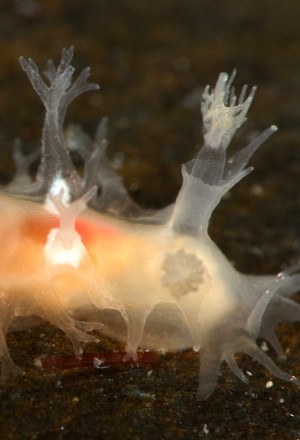
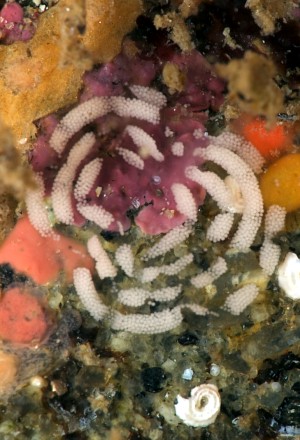
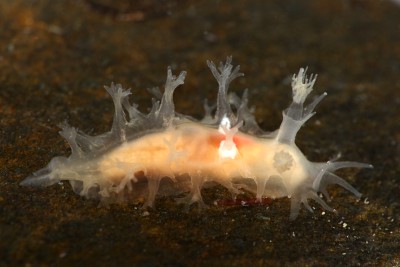
Dear Jeff & Brenna,
Thanks for this nice addition to the Forum
Best wishes,
Bill Rudman
